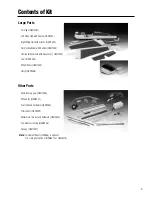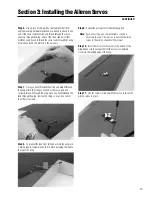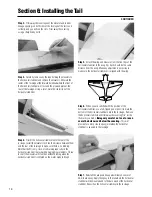
9
Step 1.
Locate the plywood wing joiner. Using the ruler,
determine the center of the wing joiner and mark it with a felt-
tipped pen or pencil.
Step 2.
Trial fit the wing joiner into one of the wing panels. It
should insert smoothly up to the center line marked in Step 1.
Now slide the other wing panel onto the wing joiner until the
wing panels meet. If the fit is overly tight, it may be necessary to
sand the wing joiner.
Step 3.
The correct dihedral angle for the wing is 0 degrees (at
the center line). Place the wing on a large flat surface one wing
panel resting on the flat surface. The other wing tip should be at
1
1
/
8
'' in height from the surface (see illustration below). If
necessary, sand the wing joiner until this is achieved. There
should be no gaps in the wing center. Once you are satisfied
with the fit, remove the wing joiner from the wing panels.
Step 4.
Mix approximately 1 ounce of 30-minute epoxy.
Note:
It is extremely important to use plenty of epoxy when
joining the wing panels together. It will also be helpful
to use wax paper under the wing center when epoxying
the wing panels together.
Step 5.
Using an epoxy brush or a scrap piece of wood, apply a
generous amount of epoxy into the wing dihedral cavity in one
wing panel.
Step 6.
Coat one half of the wing joiner with epoxy up to the
line marked in Step 1. Install the epoxy-coated side of the
dihedral brace into the wing panel cavity up to the marked
center line.
• Right/left wing panels
• Dihedral brace
• Plywood wing dowel plate
• Wooden dowels
• Wing bolt plates
• Wing trim tape
• 30-minute epoxy
• 6-minute epoxy
• Mixing stick
• Epoxy brush
• Masking tape
• Hobby knife w/#11 blade
Parts Needed
Tools and Adhesives Needed
Section 2: Joining the Wing Halves
• Rubbing alcohol
• Paper towels
• Wax paper
• Ruler
• Felt-tipped pen or pencil
• Medium sandpaper
Flat Surface
1
1
/
8
''
0
°
Summary of Contents for EDGE 540
Page 52: ...52 ...
Page 53: ...53 Template Cut Out of Cowl Bottom MDS 1 48 ...
Page 54: ...54 ...
Page 55: ...55 ...
Page 56: ... 2000 Horizon Hobby Inc www horizonhobby com ...
Page 57: ...57 ...
Page 58: ...58 ...
Page 59: ...59 ...










































